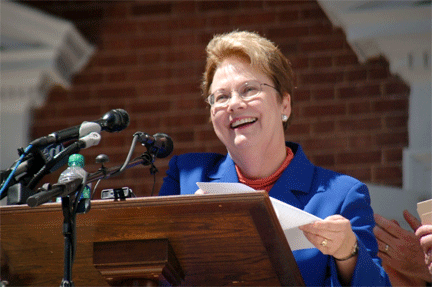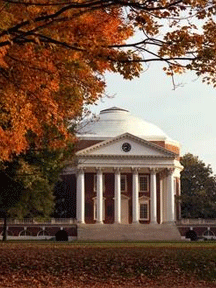The Return of Teresa Sullivan to UVA
By Jennifer M. Tharp
On December 27, 1820, Thomas Jefferson declared that the University of Virginia “will be based on the illimitable freedom of the human mind. For here we are not afraid to follow truth wherever it may lead, nor to tolerate any error so long as reason is left free to combat it.” Approximately two hundred years later, the reason of the University of Virginia community would combat the forced, secretive resignation of President Teresa Sullivan and succeed. The University’s Board of Visitors voted unanimously to reinstate Sullivan on June 26, 2012, after several weeks of controversy and campus protests. Despite Sullivan’s optimistic return, the controversy has broader implications for board communication and public education, as universities like UVA face increasing financial pressures and criticism of academic programs.
The Board of Visitors (BOV) and Sullivan announced her resignation on June 10, 2012. At that time, Sullivan officially referenced a “philosophical difference of opinion” between the board and herself. Rector Helen Dragas and Vice Rector Mark Kington of the BOV released statements that day thanking Sullivan for her work and expressing the need for UVA to remain at the “forefront of change.” However, this resignation was more than a parting over differences. Media reports soon made it apparent that Dragas and Kington had considered Sullivan’s resignation as early as June 2. Even though Dragas told Sullivan the board had enough votes to remove her, the board never collectively voted or met to discuss the decision. Throughout these proceedings, the BOV failed to keep faculty, students, and alumni adequately informed.
A faculty meeting on June 17 revealed a majority supported Sullivan, and several professors were considering resigning. Renowned computer science professor William A. Wulf did just that one week later. In an interview, Alison P. Weber, a professor of Spanish and president of UVA’s Phi Beta Kappa chapter, addressed the Board’s lack of communication by noting that “students, alumni, and faculty are also stakeholders in the future of the university, and we have knowledge and a diversity of perspectives that the members of the BOV may not have. Many on the BOV have had considerable success in business or finance, but there is no faculty representative on the board.” As to the possibility that more faculty might leave, she noted that brain drain has long been a concern at UVA due to lower salaries and research budgets.
As protests from the UVA community attracted nationwide attention, the BOV considered meeting the last week of June to discuss Sullivan’s reinstatement. On Friday June 22, Interim President Carl P. Zeithaml voluntarily suspended his appointment in consideration for the outpouring of support for Sullivan. The next day, Virginia Governor Bob McDonnell issued a statement to the BOV on June 23 asking them to address the future leadership, or he would ask for their resignations. Vice Rector Mark Kington had already resigned earlier that week. By Sunday, 3,000 people had gathered for a Rally for Honor to encourage Sullivan’s return. When Sullivan was indeed reinstated on June 26, she and Dragas walked together as a sign of solidarity, and Sullivan expressed the need for the university community to move forward together.
The struggle that UVA went through is symbolic of the struggles public universities face, as state funding shrinks and the direction of education is questioned. Specific to UVA, e-mail releases revealed that Dragas and other board members were concerned over advances in online education, university finances, and the pace of change. Peer institutions such as Stanford University, MIT, and Harvard University have initiated growing online education programs, which have attracted UVA alumni attention. Although UVA managed to provide a faculty raise of 2%, it was the first in four years. These financial struggles are exacerbated because the Commonwealth of Virginia has not made up Virginia’s shortfall. The state “provides only 8% of the university’s budget and contributes half as much per student as the University of North Carolina,” noted Weber. In regards to the pace of change, Sullivan addressed this in her resignation statement, noting that “sweeping action may be gratifying and may create the aura of strong leadership, but its unintended consequences may lead to costs that are too high to bear.”
Public universities also face nationwide criticism of undergraduate fields in the liberal arts and underperforming majors that may not be career-specific. Inside Higher Ed reported that the BOV considered cutting the German and Classics departments, although the Dean of the College of Arts and Sciences, Meredith Woo, has since denied this report. The concern with nationwide criticism of the liberal arts is that the purpose of the liberal arts is often misunderstood and vital connections between departments may not be realized until cuts have already been made. Weber noted that “we need to do a better job of explaining to the public, parents, and the students themselves what the larger objectives of a liberal arts education are and how courses in the humanities advance those goals.” In her statement, Sullivan further reinforced that a university without the full range of arts and sciences would certainly lose the respect of its peers and no longer be a full university.
This controversy has provided an intriguing microcosm of the problems facing public universities today, and an example where the interests of faculty and students succeeded in reaching a common goal. It will remain to be seen whether Teresa Sullivan and the Board of Visitors can move past their differences to guide the University of Virginia through the ever-changing educational landscape.
Jennifer M. Tharp is a senior at Carnegie Mellon University majoring in ethics history and public policy. Carnegie Mellon is home to the Upsilon of Pennsylvania chapter of Phi Beta Kappa.
Top left: The Rotunda on the UVA campus. Above: Sullivan addressing the crowd from the Rotunda steps, June 26, 2012.




